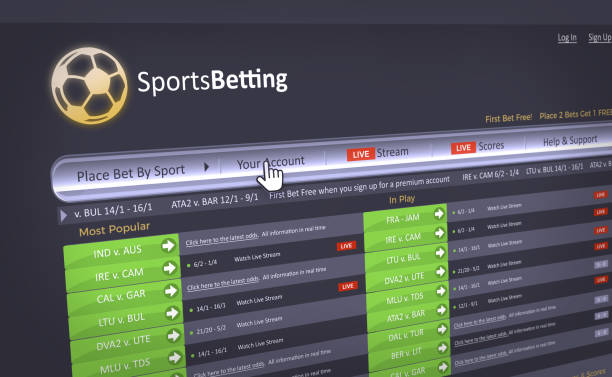Sports betting is one of the standard categories when it comes to online casinos. If you’re a sports enthusiast or fan, perhaps you can make your experience with your favorite team a bit more entertaining and thrilling if you bet. However, there are several terms you should be familiar with first before you start betting if you want to start on the right foot.
One of the primary concepts that every punter must be familiar with whenever they try to get into sports betting is the betting odds. Odds are typically represented by a number, and they can look different depending on the system that the sportsbook uses. Plus, you can find three types of odds:
- American odds
- Fractional odds
- Decimal odds
We’ll describe what betting odds represent, their importance in the sports betting world, and everything important related to this concept and why you should always have it present if you plan to become a frequent bettor (and even if you plan to do so occasionally).

What Are Betting Odds?
Betting odds are a “tool” that sportsbooks use to reveal their stance on a certain sports event, as well as how much money a punter must risk being able to get back a certain amount. In other words, betting odds tell you who’s more likely to win or lose and what you’ll get as a bettor if any of these options happen to be true.
Odds define who’s the “favorite” to win the game and who’s the “underdog” or the team who’s expected to lose the match. Typically, a favorite will have a minus (-) symbol beside its number, while the underdog will have a plus (+) sign. Let’s see an example using American odds:
Team A (-110) vs. Team B (+115)
In this example, you’d need to bet $110 to be able to win $100 if you go with the favorite (Team A). If you go with the underdog (Team B), you’ll win $115 for every $100.
Types Of Betting Odds
As mentioned above, there are three types of odds. American odds are the most used type worldwide, although it’s not unusual for certain sportsbooks to use other formats. Hence, it’s best to be familiar with all of them so that you don’t miss any good opportunities.
American Odds
The American odds are fairly easy to understand. They are also known as “the money line.” If you see a plus (+) or a minus (-) sign along a three-digit number while exploring a sportsbook and observing the upcoming matches, then you can assume that the platform is using American odds.
In this case, the negative number tells you how much you must bet to be able to get $100, while the positive number expresses how much you’ll win if you place $100 on that particular team.
However, keep in mind that there might be cases where the point spread bets will have both teams with negative odds. That is because the spread tries “to level” the advantage that one team has over the other. Hence, you may have to risk a bit more than you would profit whenever you choose to bet on the spread.
Fractional Odds
Fractional odds are also known as “British” odds or “Traditional” odds. If you’re based in the UK or Ireland, this is the type of betting odds you’ll come across more often. Bookies tend to express them using a slash (/) or a hyphen (-). The fractional odds are quite common in horse racing events.
A fractional odd may be like this: 9/5 – 1/2. The fraction actually expresses a ratio, which means that you can read them like “nine to five,” for instance.
Here we have two numbers. Let’s take the first fraction as an example:
In this fraction, 9/5, the “9” represents the number of times that the bookie supposes that the expected outcome will fail. The “5” tells you the number of times that particular outcome may succeed.
If you want to know your earnings when using fractional odds, all you have to do is multiply your bet by the fraction. For instance, let’s say that you’re putting $10 against odds of 3/1. That means that you’ll earn $30 plus the original $10 of your wager.
Decimal Odds
The last type of odds you’ll typically see in sportsbooks are decimal odds or European odds. Decimal odds are less complicated and more straightforward than the other two types. They’re typically expressed in the following manner: Team A (2.40) vs. Team B (1.61).
You can calculate how much you’ll win by multiplying the total amount of your original wager by the odds of the team you’ve chosen. Then, subtract your initial wager from the payout. Let’s say that you’re betting on the sports match given above, and you’ve chosen to bet $30 on Team A.
The formula ends up looking like this: (30 x 2.40) – 30 = $42
As you can see, decimal odds are easier to comprehend than American odds and Fractional odds. However, you’re only likely to see decimal odds in platforms based in Australia, New Zealand, Australia, and continental Europe.
Implied Probability
Now that we’ve explained the basics of odds, there’s another concept related to them that can help you figure out the best outcome for your bet. This term is known as “implied probability.” It is expressed as a percentage, and it can tell you the chances of winning for a particular team.
Implied probability is the sportsbook’s expectations of a particular outcome. Hence, you can use such a percentage to adjust your bet and make the most of it. Serious bettors widely use this concept to determine the value of their wager. For instance, let’s say that a team has 60% against an implied probability of 40%. That means that you may have an advantage over the bookie.
Each odds type explained above has a different formula to calculate the implied probability.
Implied Probability In American Odds
You can calculate implied probability using American odds by following a formula. It looks different in both underdogs and favorites. As the formula can be a bit tricky, you can use a calculator to help yourself define the numbers.
- For the favorites, the formula looks like this: Odds ÷ (Odds + 100) × 100 = Implied probability.
- For the underdogs, the formula looks like this: 100 ÷ (Odds + 100) × 100 = Implied probability.
Let’s see an example: Team A (-135) vs. Team B (+120)
In this example, Team A has an implied probability of 57.44%, while Team B has only 45.45%. This is what the sportsbook thinks of each team and how likely they are to win the match. If you believe that the chance of winning a particular team is higher than what the sportsbook says, maybe you should modify your bet accordingly.
Implied Probability In Decimal Odds
It’s easier to calculate the implied probability in Decimal odds. All you have to do is divide the odds of a particular team by 100. For example, Team A 2.40 vs. Team B 1.61
- For Team A, the formula would look like this: 100 ÷ 2.40 = 41.7%
- For Team B, the formula would look like this: 100 ÷ 1.61) 62.11%
In this case, the sportsbook thinks that Team B has a higher chance of winning than Team B. Hence, you can now adjust your bet based on the new information you have at hand.
Implied Probability In Fractional Odds
Lastly, let’s see how you can calculate implied probability in Fractional odds. The formula requires you to divide the denominator by the sum of the denominator plus the numerator. Let’s see an example:
Let’s say that Team A has 8/13 odds. In this case, the formula would look like this: 13 ÷ (13 + 8) or 13 ÷ 21 = 61.9%. As you can see, the implied probability in this example is quite high. You can apply the same principle to distinct odds to receive the implied probability of that particular team.
The Juice In Implied Probability
If you take a look at the examples given above, you’ll see that the combined implied probabilities of both teams give out a sum higher than 100%. That is because the sportsbook is still winning something in the match. It’s impossible to escape the house edge.
For instance, in the first example, we have Team A with 57.44% and Team B with 45.45%. The sum of both percentages gives out 102.89%. The remaining 2.89% would represent the percentage the sportsbook is winning in the match – all of this without considering the possibility of a tie.
FAQs
What does it mean when the odds are positive?
If you see a team with positive odds, that means they are the underdog. Hence, for instance, if a team has +120, then you would have to pay $100 to win $120 back, and so on. Positive odds tell you how much you’ll win for every $100 you bet on that particular team.
What does it mean when the odds are negative?
If you see a team with negative odds, that means they are the favorite and expected to win the match. For example, let’s say that a team has -120. That means you’ll have to bet $120 to get back $100. Hence, negative odds tell you the exact amount you’ll have to bet to win $100 on the wager.
What are Vegas odds?
Vegas odds are commonly used in Sportsbooks. Although you’ll likely have access to the money line (American odds), the bookie may have also included the “point spread” and the “total number of points” that will be scored throughout the match, based on their opinion. Hence, this makes available another type of bet, the “over/under,” where you can bet over or under the sportsbook’s score.
What is “Pick’em” in sports betting?
Some matches have no favorite or underdog. That means that both teams have the same odds during the match. For instance: Team A (+100) vs. Team B (+100). If you’re betting on the point spread, you’ll see the letters “PK” to indicate that there’s neither a favorite nor an underdog in the match.
What is a “Push” in sports betting?
This term is not directly related to odds, but it’s another option you have when it comes to betting. There’s always the possibility of a tie or a push in all matches. It’s rare to see pushes when you’re betting on the money line. However, if it’s possible for a sport to have matches end in a tie, then you will always have that option available in your preferred sportsbook.
Whenever a push occurs, you’ll be refunded all your money. You won’t lose or win anything – you’ll be able to get all your funds back, no questions asked.

Final Thoughts
We’ve explained the essential aspects of odds. This information can help you choose your bets wisely or modify those you’ve already placed. It’s important to have as much context as possible regarding a particular match so that you can make the best bet.
The information described in this article can help you figure out what your next step should be. Should you change teams, or should you increase your bet amount? That’s something you can figure out if you research the match and take into account the odds the sportsbook has established.
Although you can run the numbers and use them to your advantage to have greater chances of winning, keep in mind that everything is decided by chance. While you can try to guess what the outcome of a particular game will be, remember that no one knows what the result of the match will be. You’ll have to wait until the event is over to see if you were correct or not in the end.
Last but not least, remember to have fun while placing bets. Sports betting can be quite thrilling, especially if you’re a fan of the sport you’re betting on!








